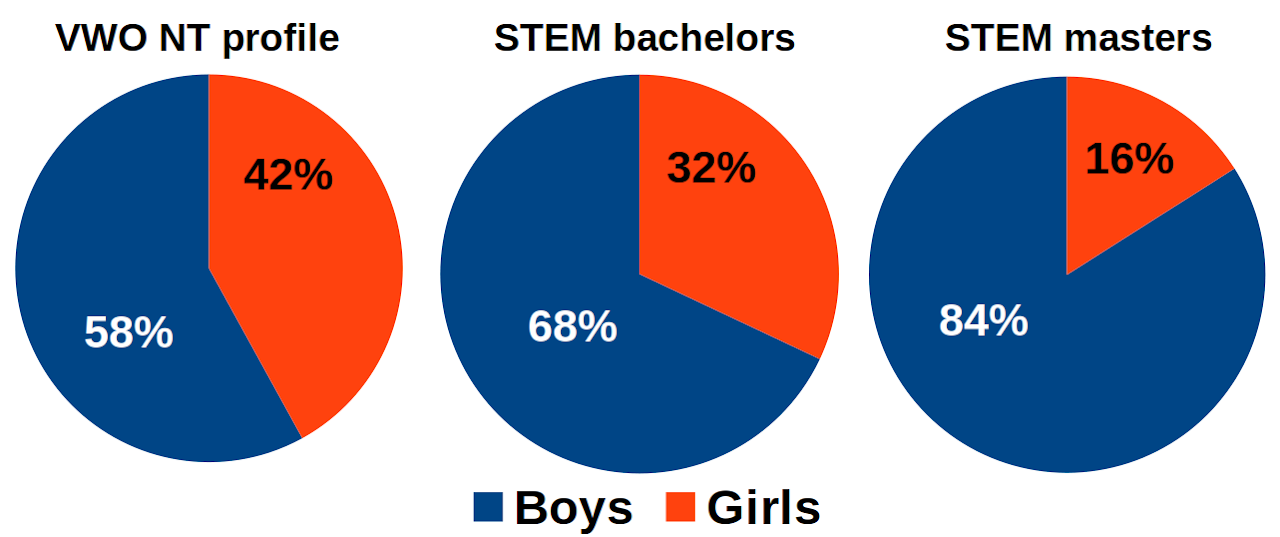[1] World Economic Forum (2015). The Global Gender Gap Report 2015. Geneva, Switzerland: World Economic Forum.
[2] Microsoft (2017). Why Europe’s girls aren’t studying STEM. White paper. https://news.microsoft.com/europe/features/dont-european-girls-like-science-technology/
[3] Huyer S., UNESCO Science Report: Towards 2030. Is the gender gap narrowing in science and engineering? UNESCO, 2015.
[4] OECD (2003). PISA dataset 2003. Paris, France: OECD.
[5] Hyde, J. S., Fennema, E., Lamon, S. J. (1990). Gender differences in mathematics performance: A meta-analysis. Psychological Bulletin, 107, 139-155.
[6] https://www.vhto.nl/cijfers-onderzoek/cijfers/cijfers-havovwo/
[7] CBS2019. WO-cohorten, diploma.
https://opendata.cbs.nl/statline/#/CBS/nl/dataset/83285NED/table?ts=1568532577091
Following STEM fields were considered: Wiskunde, natuurwetenschappen, Informatica, Techniek, industrie en bouwkunde.
[8] Booij, C., Jansen, N., Joukes, G. & Van Schaik, E. (2011). Trendanalyse gender in het bèta/technisch onderwijs. Amsterdam: VHTO, Landelijk expertisebureau meisjes/vrouwen en bèta/techniek.
[9] Eurydice Network (2011). Science Education in Europe: National Policies, Practices and Research. Brussels: Education, Audiovisual and Culture Executive Agency P9 Eurydice.
[10] Bøe, M. V., Henriksen, E. K., Lyons, T., & Schreiner, C. (2011). Participation in science and technology: Young people’s achievement‐related choices in late modern society. Studies in Science Education, 47(1), 7-37.
[11] Ceci, S. J. & Williams, W.M. (2010). The mathematics of sex. How biology and society conspire to limit talented women and Girls. New York, USA: Oxford University Press.
[12] Eccles, J. S. (2007). Where are all the women? Gender differences in participation in physical science and engineering’. In S.J. Ceci, & W.M. Williams (Eds.), Why aren't more women in science: Top researchers debate the evidence (pp. 199-210). Washington, DC, USA: American Psychological Association.
[13] Watt, H. M. G., Eccles, J. S., Durik, A. M. (2006). The leaky mathematics pipeline for girls: A motivational analysis of high school enrolments in Australia and the USA. Equal Opportunities International, 25(8), 642-659.
[14] Gender4stem Erasmus project. Identifying gender stereotypes and unconscious biases in School Education using collaborative methods
https://www.gender4stem-project.eu/fileadmin/files/documents/Deliverables/Gender4STEM_O1A1_Synthesis_FINALE.pdf
[15] Olsson, M., & Martiny, S. E. (2018). Does Exposure to Counter-stereotypical Role Models Influence Girls' and Women's Gender Stereotypes and Career Choices? A Review of Social Psychological Research. Frontiers in psychology, 9, 22-64.
[16] C. van Uffelen (2018). How can TU Delft attract more female students?
https://www.delta.tudelft.nl/article/how-can-tu-delft-attract-more-female-students
[17] Ceci, S. J. &Williams, W.M. (2010). The mathematics of sex. How biology and society conspire to limit talented women and girls. New York, USA: Oxford University Press.
[18] Dennehy T.C., Dasgupta N. (2017) Female peer mentors early in college increase women’s positive academic experiences and retention in engineering. Proceedings of the National Academy of Sciences 114 (23), 5964-5969.
[19] UNESCO. 2007. Girls into Science: A training Module. Paris, UNESCO.

